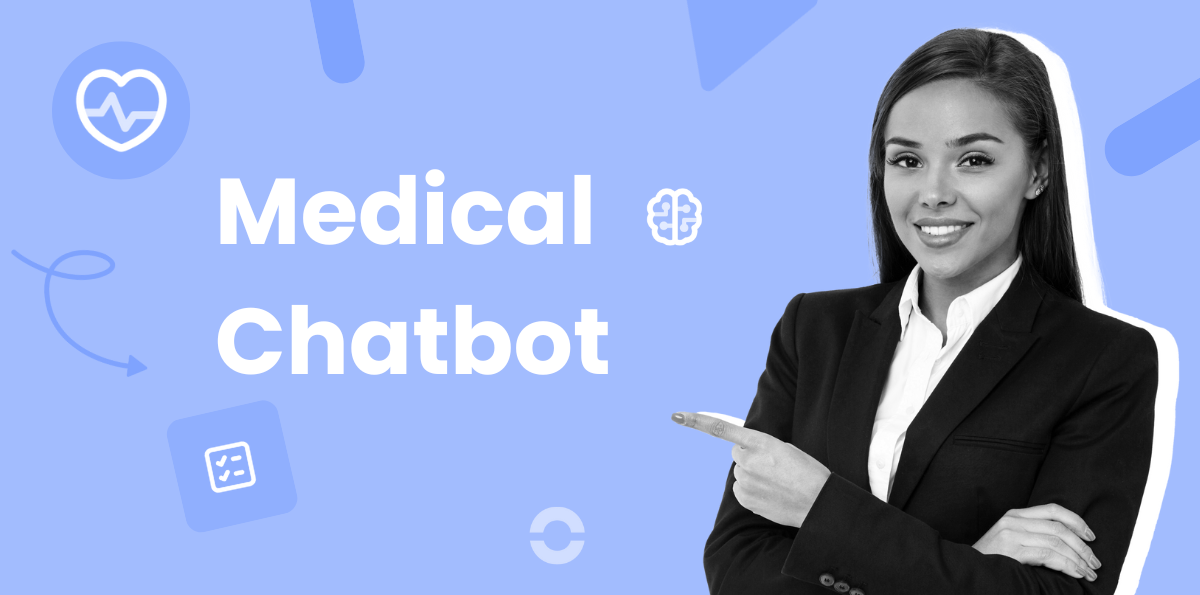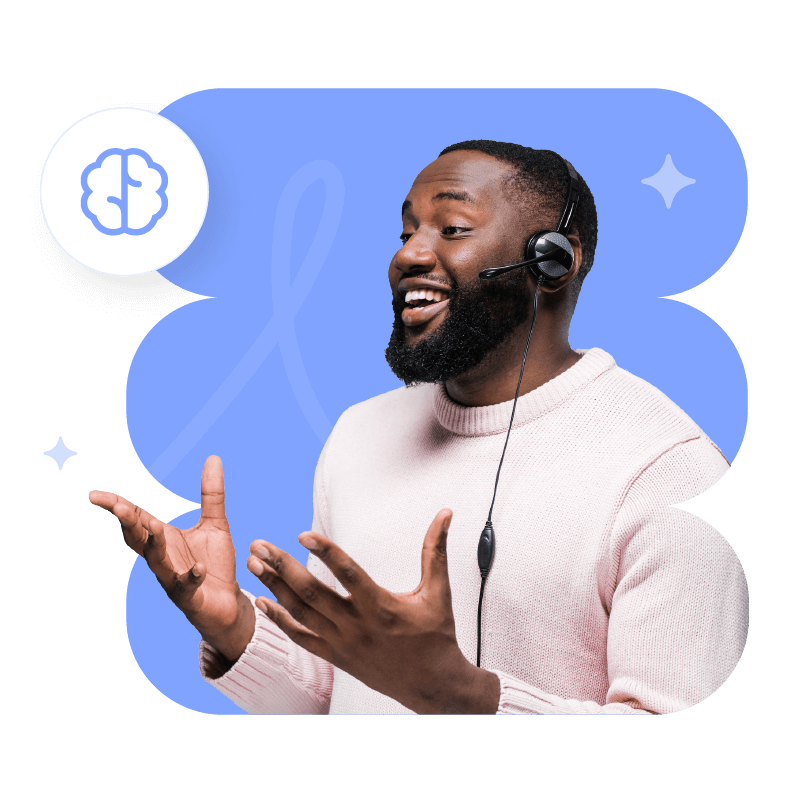Summary
- Facts and figures about medical chatbots
- What is an AI in healthcare or a medical chatbot?
- What are the main use cases for a medical chatbot?
- What are the main advantages of a medical chatbot?
- Medical chatbots: What are the disadvantages?
- Where should you start to deploy a medical chatbot?
- AI in healthcare: Your ally, if deployed well
- Medical Chatbot FAQ
- Sources
In the ever-changing world of technologies applied to healthcare, certain advances particularly stand out because they deeply transform the daily practices of both caregivers and patients. Among them are AI assistants or medical chatbots.
Their rise is real and has a significant impact. This technology is at the intersection of artificial intelligence and medicine, and these conversational agents have a real effect on the patient experience.
In this article, let's explore their uses, their advantages, and the challenges related to their adoption in the healthcare sector.
Facts and figures about medical chatbots
1️⃣ In 2023, the value of the global “health” chatbot market was around $239 million. By 2033, estimates suggest a valuation exceeding $1.35 billion (sphericalinsights). A trajectory which, with an average annual growth of around 19%, leaves little room for doubt: these conversational interfaces are becoming firmly rooted in medical practices.
But beyond the impressive figures, it's the variety of applications. Far from being a simple trend, we are witnessing the emergence of a finely integrated, sometimes almost silent logic of chatbots at the very heart of care systems. Patient intake, orientation, post-consultation follow-up, and administrative procedures–there are places where these tools are used behind the scenes.
2️⃣ According to a study by Syneos Health Communications, 64% of respondents said they were comfortable with the idea of using a virtual assistant powered by AI as part of their nursing care.
3️⃣ A study conducted by internal medicine specialist Dr. Adam Rodman and published by the New York Times reveals that ChatGPT-4 outperformed doctors in establishing diagnoses. When analyzing clinical cases, the tool developed by OpenAI achieved an average accuracy rate of 90%. Doctors using ChatGPT reached a rate of 76%, while those not using it reached 74%.
These results suggest that AI can be a valuable tool for improving the accuracy of medical diagnoses. However, this same study also points out that many doctors use the AI to its full potential. They sometimes had excessive confidence in their own judgment or used the AI in a very limited way. So with training, they would be better able to use AI in healthcare to the full extent.
What is an AI in healthcare or a medical chatbot?
Behind the somewhat abstract term "AI in healthcare" or "medical chatbot" lies a sophisticated computer program, designed to interact smoothly with its users. These can be patients or healthcare professionals.
A tool to streamline interaction, not replace the professional
The goal of such a tool is to provide an interaction that is both natural and useful, without claiming to replace clinical judgment. Especially since the uses are many and not limited to checking symptoms.
How does a medical AI assistant work?
These conversational agents rely on a set of technologies, among which Natural Language Processing (NLP) is one of the cornerstones. Thanks to this algorithmic capability, they manage to decode language as it is spoken or written, with its nuances, ambiguities…and its share of technical terms.
Making medical language accessible
This ability allows them, in particular, to rephrase a medical discourse that is often cryptic into comprehensible language—a delicate but crucial task for the clarity of the relationship between a healthcare professional and their patients.
These assistants don't just follow a rigid script. They learn, adapt their responses, and refine their suggestions. This process is possible thanks to the Machine Learning and Deep Learning components they include.
By analyzing data from past exchanges, they adjust their behavior, like a conversational partner gaining finesse with each interaction. This is no trivial thing, especially when it comes to supporting a user in such a personal and sensitive context as their health.
Some are also capable of processing speech, not just text. Often underestimated, speech analysis and sentiment analysis make the chatbot more accessible to those who have difficulty writing or who simply prefer to express themselves out loud. Plus, this can be more efficient in an emergency.
Providing support throughout the care journey
In practice, a medical AI assistant can guide a patient through the key stages of their care journey: understanding their symptoms, identifying care options, locating an available professional, even scheduling an appointment.
Support for professionals, not a substitute
A computer doesn't have the intuition or human warmth of an experienced practitioner. Their role is not to diagnose on the fly or interpret emotions. However, as a support to medical teams, they significantly lighten certain peripheral and administrative burdens. They save time—always a scarce resource in clinics and facilities. And that time can be reinvested where it truly matters: in the care relationship.
What are the main use cases for a medical chatbot?
A response to very practical needs
If medical chatbots are generating growing interest, it's above all because they respond to very operational needs in the daily life of healthcare institutions. Far from being just a technological showcase, these intelligent assistants find their place in very specific situations, where efficiency is key.
Simplified appointment scheduling
Appointment scheduling is a flagship example. A patient wants a consultation? No more need to dial a number or wait for an overwhelmed receptionist to pick up.
In just a few exchanges, the chatbot proposes a time slot, adjusts according to the patient's availability, confirms, and can even send a reminder the day before. This type of interaction, seemingly simple, reduces friction from the very first point of contact.
Smoother reception for new patients
Another frequent case: welcoming new patients. Here, chatbots act like digital guides, available at any time to answer practical questions: how to get to the clinic, what documents to bring, how the first consultation will go…
This is sometimes enriched with explanatory videos or illustrations to make the information more digestible. It's not a luxury—especially when the unknown already causes a form of apprehension.
A valuable aid to help patients with logistics
In a more logistical context, these conversational agents are also capable of locating nearby healthcare facilities: on-call pharmacies, specialist offices, screening centers...
By relying on geolocation data or an address entered by the user, they filter the options, display hours, and sometimes even reviews from other patients. In other words, it acts as a digital compass.
Assistance with treatment management
Their contribution to treatment management must also be mentioned. A field where rigor is critical, but often hard to maintain without support. AI assistants remind patients of doses, warn of potential interactions between treatments,and track refills. For patients suffering from chronic conditions or on heavy treatment, this automated monitoring not only eases their daily life but also helps establish continuity of care.
A discreet, yet constant presence
What these examples reveal is a form of discreet, yet continuous presence. Chatbots do not replace professionals—they intervene before, after, sometimes between two consultations, to fill gaps in the care journey. And it is precisely there that they add value: where humans cannot always be available, but where support is still sometimes needed.
Ringover’s AI Assistant responds to customer inquiries 24/7, handling simple tasks so your team has the time and energy to focus complex and meaningful work.
What are the main advantages of a medical chatbot?
Assistance available 24/7
One of the major strengths of medical chatbots is their continuous availability. They offer immediate assistance, any time of day or night. This is especially valuable in emergencies or when a patient needs quick answers without waiting for an office to open.
Lower costs, greater efficiency
Chatbots help automate repetitive tasks: data entry, answering frequent questions, triage requests. This automation reduces human error, improves team efficiency, and lowers operational costs for healthcare facilities.
Seamless and personalized data collection
Chatbots collect data from patients during interactions. This information can then be used to generate personalized responses, making the experience more human than that of a simple static website.
A scalable and accessible solution
Unlike a human professional, a chatbot can respond to dozens, even hundreds of users simultaneously. This high level of scalability ensures enhanced accessibility without compromising service quality.
Easier access to medical information
Chatbots can rely on trustworthy medical databases to inform patients about symptoms, conditions, or treatments. This service helps avoid certain unnecessary consultations and assists users in better understanding their health status.
Help with administrative procedures
Finally, chatbots can also respond to questions related to insurance, health coverage, and care. Information on reimbursements, invoices, coverage: they guide patients through these processes, easing the administrative workload for healthcare institutions.
Medical chatbots: What are the disadvantages?
The use of chatbots in the healthcare sector offers many advantages, but it also raises several key challenges that must be addressed.
Essential vigilance on data privacy
In healthcare, the sensitivity of shared information leaves no room for approximation. Medical history, treatments, symptoms: everything is highly sensitive. To ensure the security of this data, stakeholders must go beyond encryption and establish rigorous governance that's compliant with regulatory requirements.
Limits to medical reliability
Let's not forget that even though they are capable of guiding and suggesting hypotheses, chatbots don't replace an experienced professional. Their reasoning relies on algorithms—sometimes powerful—but lack the experience of a doctor.
The slightest error can have serious consequences, hence the need for human supervision and the continuous updating of the medical knowledge they rely on.
Lack of empathy
A positive patient experience requires empathy in addition to an accurate diagnosis and effective treatment. Unfortunately, medical chatbots don't understand silences, discomfort, or emotional nuances. There are certain situations they cannot and should not handle alone.
The need for constant updates
Medical knowledge constantly evolves, as do the rules governing its practice. To remain relevant, chatbots must be regularly revised—in collaboration with medical teams, developers, legal experts... and sometimes even users themselves, via feedback.
The challenge of user adoption
Finally, no technology is sustainably implemented without user buy-in. Healthcare professionals must be supported to integrate these tools without being burdened by them, while patients must feel they are being heard. This requires education, transparency, and concrete results on the ground.
Where should you start to deploy a medical chatbot?
To deploy such an AI assistant, one should follow a structured and methodical approach. Here are the key steps to consider for a successful implementation:
1. Clearly define the objective and scope
Before thinking about technology, you need to know why you're deploying a chatbot. Ask yourself questions such as:
- What should it be used for?
- Will it lighten repetitive staff tasks?
- Will it make following up with chronically ill patients easier?
- Does it facilitate access to information?
These choices guide the entire project. It's better to start small but focused, rather than trying to do everything at once.
2. Know your audience
A medical chatbot shouldn't speak the same way to a teenager as it does to an elderly person. The tone, features, and even the interface should change based on the user profile.
Dealing with an audience uncomfortable with digital tools? Better plan for simple navigation and, if possible, voice interactions. This step is often underestimated, but it helps to increase adoption.
3. Choose the right technological base and tool
The next step is choosing the chatbot solution and everything that comes with it: NLP engine, development platform, integrations with existing systems (data management platform, industry software, etc.). What matters here is having a reliable, secure foundation, compliant with current standards, and capable of evolving if the project grows.
4. Design and build your medical chatbot
Time to turn the idea into reality. Prototyping, testing, fine-tuning: you need to move iteratively. And above all, don't do it in isolation. Dialogue between developers, healthcare professionals, and end users is essential to building something truly relevant.
Depending on your chosen providers, you may benefit from the support of an AI expert throughout the development, testing, and deployment phases.
5. Take it step by step
No need to aim for full automation of patient journeys right away. A progressive approach—often called “Crawl-Walk-Run”—helps secure the launch.
Start by automating simple, high-volume tasks: FAQs, reminders, appointment scheduling... Observe, learn, improve.
6. Test in real-life conditions
Once the bot is operational, it needs to be tested in the field. Test it with a representative sample, analyze interactions, identify misunderstanding zones, and adjust responses.
This validation phase is crucial to avoid releasing a tool that could frustrate rather than help.
7. Track the results
Finally, to know if the project delivers on its promises, you must set metrics such as:
- User satisfaction
- Usage rate
- Time saved for caregivers
- Reduction in call volume, etc.
These data points help anchor the project long-term, offer reference points, and redirect if necessary.
AI in healthcare: Your ally, if deployed well
The rise of medical chatbots perfectly illustrates how artificial intelligence is entering the workings of the healthcare system, not to replace humans, but to support them. Available at all times, capable of managing repetitive tasks and streamlining access to information, these conversational assistants meet concrete needs for both patients and professionals.
But their effectiveness should not overshadow the necessary precautions. Data security, content reliability, emotional limitations: so many points of attention to be integrated from the design stage. If their potential is very real, their sustainable adoption depends on a thoughtful, supervised implementation centered on the human experience.
In summary, medical chatbots are not to be seen as a panacea, although they remain valuable tools among others to improve the accessibility and responsiveness of care. For them to truly add value, it is crucial to clearly define the areas in which they will be integrated, determine the method of use, and understand the objectives to be achieved.
Do you have questions about AI assistants? Start a conversation with our experts on the matter.
Medical Chatbot FAQ
How do chatbots work in the field of medicine?
Medical chatbots or health chatbots rely on advanced algorithms and are continuously fed from structured, often vast, medical resources. Their role is to interact with patients throughout the care journey:
- Reduce unnecessary waiting
- Ease the pressure on medical structures
- Provide appropriate guidance
- Gather information
- Make diagnostic hypotheses
- Assist patients in administrative procedures
Are medical chatbots customizable?
Yes, medical chatbots are highly customizable. Their adaptability is an integral part of their value. They can be calibrated according to the realities of a hospital department, a teleconsultation center, or even a network of specialized care.
This degree of customization can go far: a chatbot can take into account medical history, modulate its responses based on known allergies, or even provide specific instructions after a treatment, in the patient's preferred language. In a healthcare system where personalization is often a luxury, this type of digital interface offers a practical, accessible, and surprisingly human extension in how it adapts.
How is a medical chatbot trained?
The training of a medical chatbot does not depend on a linear process. It fits into a continuous dynamic, fueled by clinical data sets, but also exchange scenarios, and adjustments made by multidisciplinary teams involving engineers and healthcare professionals.
This work is mainly based on machine learning techniques coupled with natural language processing models. One might think it all relies on technology, but that would miss the essential: the successive validations, carried out by doctors and industry experts, are what ensure the relevance of the responses. Without this step, the models remain blind to medical nuance.
How is data confidentiality managed in a medical chatbot?
Data confidentiality is a major priority for medical chatbots. Developers implement robust security measures, such as data encryption, user authentication, and compliance with healthcare data protection regulations, such as the GDPR.
The information collected must be stored securely and only accessible by authorized persons, to ensure the confidentiality and integrity of patients' sensitive data.
How much does a medical chatbot cost?
The cost of a medical chatbot can vary significantly depending on several factors, such as:
- Functional scope,
- Desired level of integration,
- Degree of customization required by the institution
As for cost, generally, several aspects must be considered: the initial development, regular maintenance (which often includes updates related to medical protocols), and integration with existing health information systems.
This type of investment may seem substantial at first. However, in hindsight, many institutions notice a significant return: fewer redundant tasks for healthcare professionals, better patient guidance, and overall efficiency that ultimately results in both economic gains and improved service quality.
Sources
- https://www.sphericalinsights.com
- https://syneoshealthcommunications.com/
- https://wikipedia.org/
- https://www.nytimes.com/
Published on May 12, 2025.



